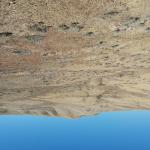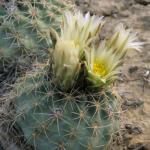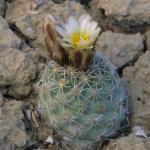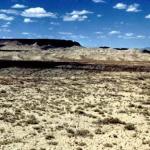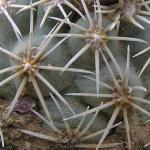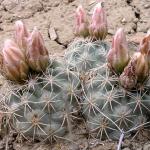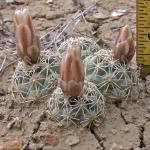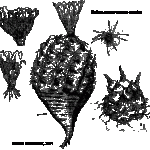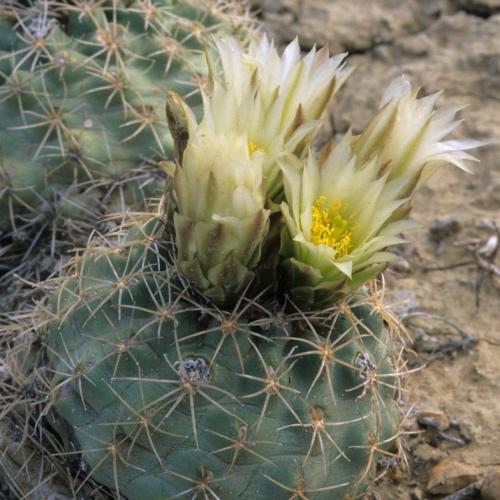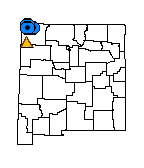Sclerocactus mesae-verdae (Mesa Verde Cactus)
COLORADOA MESAE-VERDAE BOISSEVAIN
| USFWS | State of NM | USFS | BLM | Navajo Nation | State Rank | Global Rank | R-E-D Code | NMRPTC Status | Strategy Status |
|---|---|---|---|---|---|---|---|---|---|
| LT | E | GP 2 | S2 | G2 | 2-2-2 | R | SS |
| Overall Conservation Status | Documented Threats | Actions Needed |
|---|---|---|
| UNDER CONSERVED | Climate change/drought. Predation. Urban development. Off-road vehicle use. Oil & gas develoment. Powerlines & powerline maintenance. Road construction and maintenance. |
Status surveys on abundance, distribution and threats (dust, rodents/rabbits, beetles, invasives), seed banking. Trend monitoring. Study threat impacts. |
Stems usually solitary, depressed-globose to ovoid, 3.2-11.0 cm long, 3.8-8.0 cm in diameter; ribs 13-17; tubercles inconspicuous; areoles woolly; central spines absent or rarely 1, radial spines 7-13, straw-colored, spreading, 6-13 mm long; flowers yellowish-cream to pinkish, 1-3 cm wide, 1-3.5 cm long; fruit green, becoming tan at maturity, short cylindroid, 8-10 mm long, indehiscent; seeds black, 2.5-3 mm long, 3-4 mm wide. Flowers late April to May.
Sclerocactus parviflorus ssp. intermedius (eagle-claw cactus) can grow in the same habitat, but has strongly hooked central spines and pinkish-purple flowers.
New Mexico, San Juan County; Colorado, Montezuma County.
Sparsely vegetated low rolling clay hills formed from the Mancos or Fruitland shale formations at 1,500-1,700 m (4,900-5,500 ft). The soils are highly alkaline, gypsiferous, and have shrink-swell potentials that make them harsh sites for plant growth. Commonly associated plants include Atriplex corrugata (mat saltbush), A. confertifolia (shadscale), Frankenia jamesii (frankenia), and Opuntia polyacantha (prickly pear cactus).
Plants withdraw into the soil during dry periods; small plants may be completely hidden.
Oil and gas development and , OHV impacts, trash dumping, grazing impacts, insect outbreaks, and invasive species all contribute to the documented decline of the species.This plant is very difficult to keep alive under cultivation because of its specialized soil requirements, so there are few commercial sources of plants. As a result, signs of limited collecting are periodically seen at the best known localities. Populations crashed rangewide in 2002/2003 in response to a drought related insect outbreak. Populations did not recover by 2020.
*New Mexico Native Plants Protection Advisory Committee. 1984. A handbook of rare and endemic plants of New Mexico. University of New Mexico Press, Albuquerque.
*Heil, K.D. and J.M. Porter. 1994. Sclerocactus (Cactaceae): A revision. Haseltonia 2:20-46.
Roth, D. 2020. Monitoring report, Mesa Verde cactus (Sclerocactus mesae-verdae). 1986-2020. Unpublished report prepared by the EMNRD-Forestry Division, for the USFWS, Region 2. http://www.emnrd.state.nm.us/SFD/ForestMgt/endangeredandrareplantreports.html
Roth, D. 2020. Status report. Mesa Verde cactus (Sclerocactus mesae-verdae). BLM Hogback ACEC, Waterflow, NM. Unpublished report prepared by the EMNRD-Forestry Division, for the USFWS, Region 2. http://www.emnrd.state.nm.us/SFD/ForestMgt/endangeredandrareplantreports.html
*U.S. Fish and Wildlife Service. 1984. Mesa Verde cactus (Sclerocactus mesae-verdae) recovery plan. U.S. Fish and Wildlife Service, New Mexico Ecological Services Field Office, Albuquerque, New Mexico.
For distribution maps and more information, visit Natural Heritage New Mexico

